Use of captured "Panthers" and "Tigers" at the final stage of the Great Patriotic War
The peak of the use of captured German armored vehicles in the Red Army came in early 1942 - mid-1943.
In the second half of the war, domestic industry was able to satisfy the demands of the active army in tanks and self-propelled artillery installations. Although not all was well with the quality of the products, in terms of numbers, medium and heavy tanks, as well as self-propelled guns, were quite enough to form new units and make up for losses.
In conditions of saturation of the Red Army units with Soviet armored vehicles, the value of captured tanks and self-propelled guns sharply decreased. A certain role was played by the fact that by the middle of 1943 there was a very serious qualitative strengthening of the German anti-tank artillery.
New and modernized Panzerwaffe tanks received long-barreled 75-88-mm guns with increased armor penetration and thicker armor. This is despite the fact that among the captured armored vehicles there was a high proportion of tanks and self-propelled guns captured by the Red Army in a damaged form in 1941-1942. And subsequently restored at repair enterprises located deep in the rear. The combat value of vehicles protected by 50-mm frontal armor and armed with 50-mm or 75-mm short-barreled guns decreased by the summer of 1943.
Taking into account the fact that after the summer battles of 1943, Germany on the Eastern Front switched to strategic defense, and the battlefield increasingly remained behind the Red Army, the number of captured German armored vehicles increased. According to archival documents, the trophy teams collected 24 German tanks and self-propelled artillery units.
It is clear that a significant part of them were exposed to flames or were destroyed as a result of an internal explosion of ammunition. But even German tanks to be restored were in most cases scrapped.
After the Red Army began large-scale offensive operations, the attitude towards captured tanks and self-propelled guns changed.
Since mid-1943, our repair units and enterprises in the rear were primarily aimed at restoring domestic armored vehicles. And captured vehicles requiring a lot of labor and the use of non-standard spare parts and components were of much less interest.
However, if our troops managed to capture serviceable or requiring minimal repairs armored vehicles, they were often put into operation.
In order to streamline the use of captured tanks on October 24, 1944, the head of the Main Armored Directorate of the Red Army (GBTU SC), Marshal Ya.N. Fedorenko issued an order:
However, even before the release of this instruction, captured armored vehicles were very often used to provide cover in the frontline zone of the headquarters of regiments and divisions, warehouses, hospitals, bridges and pontoon crossings. Sometimes captured German tanks were attached to the commandant's offices.
Use of captured Pz.Kpfw.II and Pz.Kpfw.III tanks at the final stage of hostilities
Oddly enough, at the final stage of the war with Nazi Germany, the seemingly hopelessly outdated PzII and Pz.Kpfw.III captured tanks continued to be used in the Red Army.
In the case of the "twos", they were mainly Pz.Kpfw.II Ausf. C and Pz.Kpfw.II Ausf. F. Light tanks of these modifications in a combat position weighed about 9,5 tons. The thickness of the frontal armor of the hull and turret was 29–35 mm, and the side armor was 15 mm. There is information that part of the "twos" were rearmed with 20-mm automatic cannons TNSh-20 and machine guns DT-29.
Although in 1944-1945. "Twos" could not withstand medium and heavy tanks, their armament was capable of successfully operating against infantry, trucks and armored personnel carriers not hiding in the trenches, and the armor reliably protected against small arms weapons... Considering that the captured Pz.Kpfw.II tanks had no chance of surviving on the battlefield, they were mainly used to guard objects in the rear and to escort convoys. Light tanks could fight sabotage groups and enemy infantry breaking through from the encirclement.
For the most part, trophy "troikas" in the second half of the war were used in the same way as "twos". However, given that the Red Army captured much more Pz.Kpfw.III medium tanks than Pz.Kpfw.II, the range of their use was much wider.
Although the firepower and protection of the latest modifications of the Pz.Kpfw.III at the final stage of hostilities could no longer be considered satisfactory, in addition to guarding functions in the rear, captured Pz.Kpfw.IIIs sometimes operated on the front lines. Due to the presence of a commander's cupola, good optical instruments and a radio station, the "troikas" were often used as command tanks and vehicles of forward artillery observers.
Even after the surrender of Germany, a certain number of Pz.Kpfw.II and Pz.Kpfw.III remained in the Red Army. So, in the units of the Trans-Baikal Front that participated in hostilities against Japan in August 1945, there were Pz. Kpfw.II and Pz.Kpfw.III.
Use of captured Pz.Kpfw.IV tanks of later modifications
Taking into account the fact that by the second half of 1942 the modernization potential of the Pz.Kpfw.III was almost exhausted, the Pz.Kpfw.IV became the main medium German tank. The consistent increase in firepower and protection allowed the "four" to remain operational until the end of hostilities and on an equal footing withstand the most advanced medium Soviet and American tanks.
Many historians specializing in armored vehicles of the Second World War believe that the Pz.Kpfw.IV of late modifications with a long-barreled 75-mm gun is the most successful type of German tank in terms of cost-effectiveness. Since 1943, the Quartet has become the Panzerwaffe's workhorse. Until April 1945, 8575 tanks of this type were built at the enterprises of the Third Reich.
In March 1942, production of the Pz.KpfW.IV Ausf.F2 tank began, armed with a 75 mm 7,5 cm Kw.K.40 L / 43 cannon and protected in frontal projection with 50 mm armor.
The Pzgr.39 armor-piercing projectile weighing 6,8 kg, leaving the barrel with an initial velocity of 750 m / s, at a distance of 1000 m along the normal could penetrate 78-mm armor, which made it possible to confidently fight the thirty-fours. A medium tank of the Pz.KpfW.IV Ausf.G modification, with 80-mm frontal armor, was armed with the Kw.K.1943 L / 40 cannon in the spring of 48. The armor-piercing 75-mm projectile of this gun with an initial speed of 790 m / s, at a distance of 1000 m, pierced through and through with an 85-mm armor plate.
Sufficiently thick frontal armor and high armor penetration of the gun, combined with good sights and observation devices, made the "four" a very serious enemy.
Soviet 76,2-mm guns F-32, F-34 and ZIS-5, mounted on KV and T-34 tanks, when firing with an armor-piercing blunt-headed projectile BR-350B had a chance to penetrate the frontal armor of the German "Quartet" built in 1943 , at a distance of no more than 400 m.
In part, the fight against the later versions of the Pz.Kpfw.IV was facilitated by the fact that the increase in firepower and protection was accompanied by an increase in combat mass, and, as a result, a decrease in mobility and passability on soft soils. The Pz.KpfW.IV Ausf.F1 tank, which weighed 22,3 tons and armed with a short-barreled 75 mm KwK.37 cannon, had a specific power of 13,5 liters. sec. / t and specific ground pressure of 0,79 kg / cm².
In turn, the Pz.Kpfw.IV Ausf.H with a 75-mm 48-caliber cannon, launched in series in April 1943, weighed 25,7 tons. Its power density was 11,7 liters. sec / t, and the ground pressure is 0,89 kg / cm².
In addition, the thickness of the side and frontal armor of the turret of later modifications remained the same as on the Pz.KpfW.IV Ausf.F1, which was easily penetrated by a 45 mm armor-piercing projectile at real combat distances.
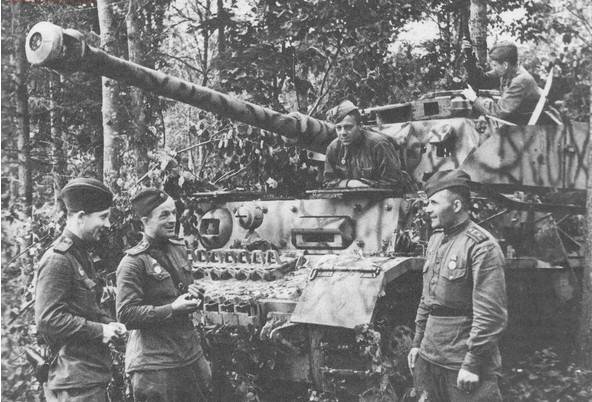
Tank Pz.lV Ausf N, captured by Soviet troops west of Orel. June 1943
Before the appearance of the T-34-85 medium tanks and the IS-1/2 heavy tanks, German Pz.Kpfw.IV tanks, armed with 75 mm guns with 43 and 48 caliber barrels, were a very coveted trophy. The trophy "four", mastered by an experienced crew, could successfully fight the same type of vehicles at a distance almost twice as long as domestic tanks armed with 76,2-mm cannons.
Even after during the offensive operations of 1944-1945. Soviet troops began to quite often capture German heavy tanks and self-propelled guns with long-barreled 75 and 88-mm guns, Pz.KpfW.IV tanks continued to be used in the Red Army. This was largely due to the fact that the "four" was easier to repair than, for example, "Panthers" and "Tigers". Due to its high prevalence, it was easier to find spare parts and shots for the 75mm cannon for it.
The use of the Pz.Kpfw.V Panther tanks in the Red Army
The combat debut of the Pz.Kpfw.V Panther on the Eastern Front took place in July 1943 near Kursk. The first experience of combat use of tanks "Panther" revealed both the advantages and disadvantages of the tank.
Among the advantages of the new tank, German tankers noted reliable protection of the frontal projection of the hull, a powerful cannon, which made it possible to hit all Soviet tanks and self-propelled guns head-on beyond the range of their effective fire, and good sighting devices.
However, the tank's side armor was vulnerable to 76,2 mm and 45 mm armor-piercing shells at the main battle distances. The combat value of the tank was largely reduced by its low technical reliability. The chassis and transmission were often out of order, and the Panther engines of the first modifications were prone to overheating and sometimes ignited spontaneously.
Although the mass of the tank was about 45 tons, according to the German classification, it was considered average. Armor protection "Panther" was differentiated and had large angles of inclination. The upper frontal armor plate 80 mm thick was located at an angle of 57 ° from the vertical. The lower frontal plate 60 mm thick had an inclination angle of 53 °.
The upper side plates of the hull 40 mm thick (on later modifications - 50 mm) are inclined to the vertical at an angle of 42 °. The lower side plates were installed vertically and had a thickness of 40 mm. The welded tower in the frontal projection was protected by a 100 mm thick mask. Stern and side armor of the tower - 45 mm, inclination 25 °.
The first serial "Panthers" were equipped with a 650 hp carburetor engine. sec., providing speed on the highway up to 45 km / h. Since May 1943, it was replaced by a 700 hp engine. from. The maximum speed of the tank remained almost unchanged, but the increase in power density made it possible to feel more confident off-road.
The undercarriage of the tank with a staggered arrangement of road wheels provided a good ride, which made it easier to aim the gun in motion. But at the same time, such a chassis design was difficult to manufacture and repair, and also had a large mass.
The Pz.Kpfw.V tank had very powerful weapons. The 75-mm KwK 42 tank gun with a barrel length of 70 calibers, the Pzgr 39/42 armor-piercing projectile, accelerated to 925 m / s, at a distance of 1000 m at a 60 ° meeting angle, penetrated 110-mm armor. The Pzgr 40/42 sub-caliber projectile, which left the barrel with an initial speed of 1120 m / s, pierced 150 mm armor under the same conditions.
Taking into account the fact that a well-trained crew could fire 8 aimed shots per minute, the gunner had very good sighting devices at his disposal, and the gun itself had high accuracy - all this made the Panther deadly for any tank of the Second World War. In addition to the 75 mm gun, the tank was armed with two 7,92 mm MG.34 machine guns.
The appearance of the Pz.Kpfw.V tank, which was formally considered average, was largely due to the comprehension of the experience of collisions with new types of Soviet tanks in the initial period of the war.
In many ways, "Panther" corresponded to the ideas of the Wehrmacht command about the ideal "anti-tank tank". And it fit well into the defensive military doctrine of Germany, adopted in the second half of 1943.
Strong frontal armor, very high penetration and accuracy of a moderate caliber gun that used expensive rounds, and a small turret with a thick mask - all these are characteristic features of a defensive tank.
Best of all, "Panthers" showed themselves in active defense in the form of ambushes, shelling of advancing enemy tanks from long distances and counterattacks, when the influence of weakness of the side armor is minimized. Serial production of Pz.Kpfw.V tanks lasted from January 1943 to April 1945. A total of 5995 copies were built.
Possessing good anti-armored capabilities, the Pz.Kpfw.V tanks were very expensive and difficult to manufacture and maintain. The use of a staggered layout of the road wheels, which ensured a smooth ride, adversely affected the reliability and maintainability of the chassis. Replacing the internal road wheels damaged by mine explosions or artillery fire was a laborious operation. The liquid mud that had accumulated between the road wheels often froze in winter and completely immobilized the tank.
Often there was a situation when the crews of "Panthers", having won a fire duel with Soviet tanks, were forced to abandon them, due to breakdowns or the inability to refuel. Quite often, immobilized German tanks were dug into the ground along the tower and used as fixed firing points.
In the last year of the war, our troops captured a significant number of serviceable and damaged, but suitable for restoration, Pz.Kpfw.V tanks.
At the same time, Soviet troops exploited captured Panthers very limitedly. By the middle of 1943, the Red Army already had experience in operating the Pz.Kpfw. 38 (t), PzKpfw. II, Pz. Kpfw.III and Pz. Kpfw.IV, as well as self-propelled guns based on them. However, the use of the Pz.Kpfw.V was a very difficult task, requiring appropriate crew training and a repair base.
Soviet tank crews, who did not have the necessary experience in operating complex and specifically designed equipment, often put Panthers out of action, having driven 15–20 km, and could not then repair them due to the lack of the necessary spare parts, tools and experience in repairing such vehicles.
Here is what the headquarters of the 4th Guards Tank Army reported to the GBTU KA:
To power the tanks, it is necessary to provide for an uninterrupted supply of high quality aviation gasoline.
In addition, there are big problems with ammunition for the German 75-mm tank gun mod. 1942 (Kw.K. 42), since the ammunition from the gun mod. 1940 (Kw.K.40) unsuitable for use in the Panther tank.
We believe that a German tank of the Pz.Kpfw.IV type is more suitable for conducting covert offensive operations, which has a simpler device, is easy to operate and repair, and is also widespread in the German army. "
However, given that the Pz.Kpfw.V tank was armed with a weapon with very high ballistic characteristics, this made it possible to fight enemy armored vehicles at distances exceeding the effective firing range of Soviet 76,2-85-mm tank guns.
In the first half of 1944, the GBTU SC considered the use of serviceable captured Panthers as tank destroyers. In March 1944,
The commissioning and successful operation of captured Pz.Kpfw.V tanks largely depended on the personal position of the commanders of Soviet tank formations.
So, in January 1944, by order of the deputy commander of the 3rd Guards Tank Army, Major General Yu. Solovyov, in the 41st and 148th separate repair and restoration battalions, one platoon of the most experienced repairmen was created, who were involved in the repair and maintenance of the Panther ".
In a number of cases, captured "Panthers" very successfully played the role of tank destroyers. Soon after the commissioning of the crew of the Soviet "Panther" during the hostilities in the north-west of Ukraine near the village of Zherebki knocked out a tank "Tiger".
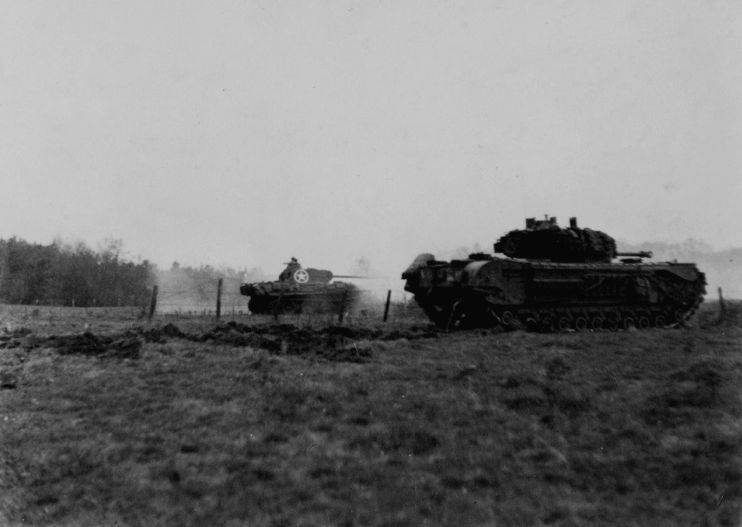
A captured Panther tank next to a British-made Churchill heavy tank.
Most of all in the "Panther" our tankers were attracted by the armament: the ballistic data of the 75-mm KwK.42 gun made it possible to knock out German tanks at distances inaccessible to any Soviet tank (and anti-tank) gun.
In addition, an excellent radio station and guidance devices by the standards of that time made the Panther a good command vehicle.
So, for example, the 991st SAP (46th Army of the 3rd Ukrainian Front) had 16 SU-76M and 3 Panthers, which were used as command vehicles.
In the spring of 1945, the 366th GSAP, which fought as part of the 3rd Ukrainian Front, besides heavy self-propelled guns ISU-152, several captured SU-150 (Hummel) and SU-88 (Nashorn), had 5 Pz.Kpfw. V and one Pz.KpfW.IV.
However, it was difficult to use captured tanks in the same battle formations with Soviet-made tanks and self-propelled guns. The Pz.Kpfw.V drivers had to choose the route very carefully. Where the light ACS SU-76M passed freely, the heavy Panther could get stuck.
Big problems also arose with overcoming water barriers. Not all bridges could withstand a tank weighing 45 tons, and when fording the river, there were almost always difficulties with the Pz.Kpfw.V reaching the steep bank.
In addition, there was a risk of shelling the captured Panthers with their tanks and artillery. And the big stars painted on the towers didn't always help.
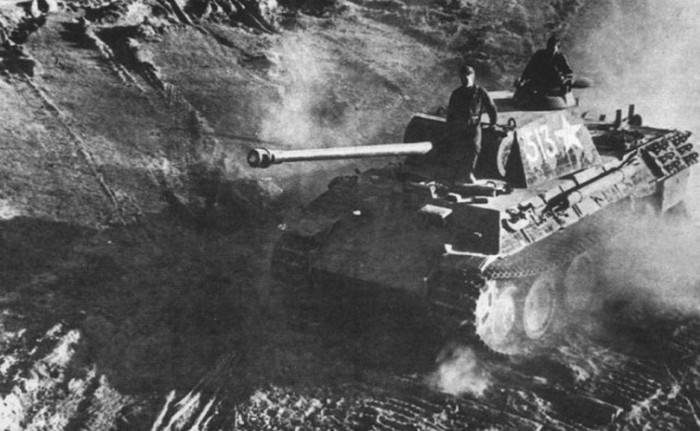
The photographs of the "Panthers" of the tank company commanded by the guard senior lieutenant M.N. Sotnikov.
Three captured Pz.Kpfw.V tanks were included in the 62nd Guards Tank Regiment of the breakthrough of the 8th Guards Tank Corps.
These Pz.Kpfw.V tanks were previously part of the 5th SS Panzer Division Viking, and were captured in battle on August 18, 1944 near the town of Yasenitsa.
Unfortunately, it was not possible to find information about the combat use of Panthers by Sotnikov's company. Apparently, these vehicles were used as an anti-tank reserve.
It was difficult to use captured Pz.Kpfw.Vs together with thirty-fours.
The Panther's passability was much worse, and the speed of movement on the march was lower. In addition, the Maybach gasoline engines were gluttonous. At one gas station along the Panther highway, it could cover about 200 km, and the cruising range of the Soviet medium tank T-34-85 was 350 km.
Due to the low reliability of the engine, transmission and chassis, breakdowns often occurred, and the Panthers had to be towed to the place of repair.
But, despite operational problems, difficulties with repairs, supply of ammunition and fuel and lubricants, captured Pz.Kpfw.V tanks continued to remain in service with the Red Army until the surrender of Germany.
Use of Pz.Kpfw.VI Tiger tanks in the Red Army
The first case of combat use of the heavy tank Pz.Kpfw.VI occurred in September 1942 near Leningrad. Several "Tigers" tried to attack off-road under the fire of Soviet artillery. In this case, one tank was captured by the Red Army.
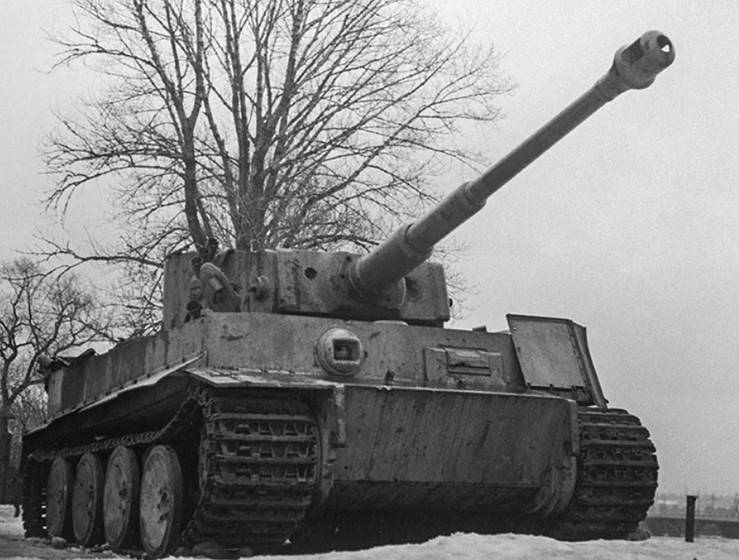
The enemy used the heavy tanks much more successfully during Operation Citadel.
The Tigers were used to break through the Soviet defenses, often leading groups of other tanks. The powerful armament of the Pz.Kpfw.VI made it possible to hit any Soviet tank, and the armor protected from 45-76,2 mm armor-piercing shells.
The 88 mm Kw.K.36 tank gun was created on the basis of the FlaK 18/36 anti-aircraft gun. This gun accelerated the Pzgr. 39/43 with a mass of 10,2 kg to 810 m / s, which at a distance of 1000 m ensured penetration of 135 mm armor. A 7,92 mm MG.34 machine gun was paired with the gun, and another machine gun was at the disposal of the radio operator.
The thickness of the frontal armor of the hull was 100 mm, the side and rear of the hull were 80 mm. The forehead of the tower is 100 mm, the side and rear of the tower are 80 mm. The first 250 early-production tanks were fitted with a 650 hp gasoline engine. with., and on the rest - 700 hp. The individual torsion bar suspension with a staggered arrangement of rollers ensured a high smoothness of the ride, but it was very vulnerable to combat damage and difficult to repair.
In 1942-1943. in terms of the aggregate fighting qualities "Tiger" was the strongest tank in the world. The advantages of the machine include powerful armament and armor, well-thought-out ergonomics, high-quality observation and communication devices.
However, the price that had to be paid for the powerful weapons and thick armor was very high. The tank with a combat weight of 57 tons had a specific power of about 12 liters. sec / t and specific ground pressure of 1,09 kg / cm², which did not allow you to feel confident in deep snow and on wet ground.
High combat performance was largely discounted by the high complexity and cost of production, and low maintainability. Due to its large mass, the damaged tank was difficult to evacuate from the battlefield.
Due to the fact that 1347 Pz.Kpfw.VI tanks were built, Soviet troops captured them much less frequently than Panthers. The first documented case of the Soviet crew mastering the captured Tiger took place at the end of December 1943.
On December 27, during the attack of the 501st heavy tank battalion of the Wehrmacht, one of the vehicles got stuck in a crater and was abandoned. Tankers of the 28th Guards Tank Brigade (39th Army, Belorussian Front) managed to pull out the Tiger and tow it to their location.
The tank was quickly put into operation, and the brigade command decided to use it in battles. The Journal of Combat of the 28th Guards Tank Brigade says the following about this:
The crew of the T-6 tank was appointed commander of the brigade, consisting of: the commander of the tank three times Order-bearer of the Guard Lieutenant Revyakin, the driver-mechanic of the Guard Sergeant Major Kilevnik, the commander of the gun of the Guard Sergeant Major Ilashevsky, the commander of the tower of the Guard Sergeant Major Kodikov, the gunner-radio operator of the Guard Sergeant Akulov.
The crew mastered the tank within two days.
The crosses were painted over, instead of them two stars were painted on the tower and "Tiger" was written.
Later, another German heavy tank was captured by the 28th Guards Tank Brigade.
As of July 27, 1944, the brigade had 47 tanks: 32 T-34, 13 T-70, 4 SU-122, 4 SU-76 and 2 Pz.Kpfw.VI. "
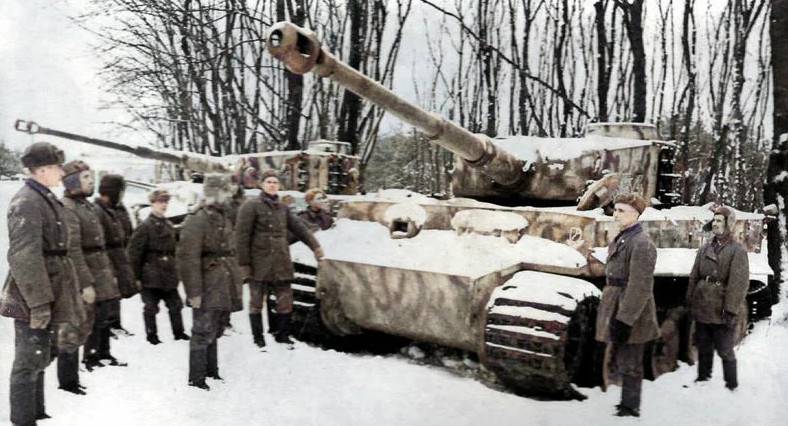
The 713th self-propelled artillery regiment of the 48th Army of the 1st Belorussian Front and the 5th Separate Guards Tank Brigade of the 38th Army of the 4th Ukrainian Front also had one captured Tiger each.
However, due to the small number and operational problems, the captured Pz.Kpfw.VIs had practically no effect on the course of hostilities.
This was largely due to poor maintainability. If on Soviet tanks many malfunctions could be eliminated by the crew, then repairing the Tiger in most cases required the involvement of well-trained specialists and special equipment.
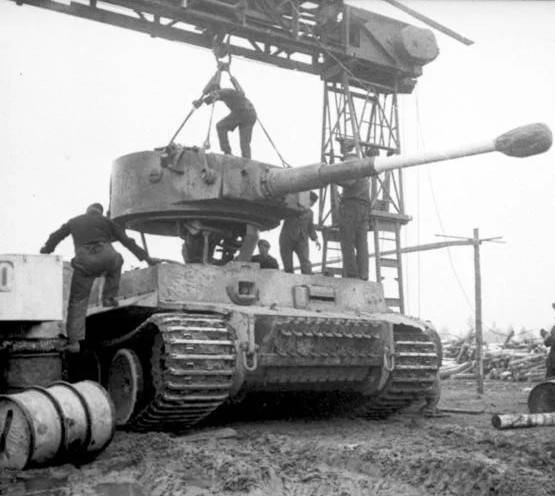
Replacing damaged rollers in the inner row could take more than 12 hours. And to access the faulty transmission, it was required to dismantle the tower, which was impossible without the use of crane equipment with a lifting capacity of at least 12 tons.
As a result, such disadvantages as the complexity of the repair, multiplied by operational problems, the need to refuel with scarce fuels and lubricants and the use of non-standard 88-mm shots with an electric igniter, outweighed the advantages of the German heavy tank.
At the final stage of the war, the Red Army received sufficient numbers of medium and heavy tanks armed with 85-122-mm guns, and self-propelled guns with 100-152-mm guns, which at real battle distances could successfully hit any enemy armored vehicles. And captured "Tigers" in the role of tank destroyers have lost their significance.
Talking about heavy German tanks in the Red Army, it will be correct to mention another vehicle captured by Soviet troops at the end of the war. Serial production of the heavy tank Pz.Kpfw.VI Ausf. B Tiger II ("Royal Tiger") began in November 1943 and continued until March 1945. A total of 490 copies were built.
Despite the designation similar to the first "Tiger", in fact it was a new car.
The main purpose of the Tiger II was to combat enemy tanks at the maximum possible distance. For this, the tank was armed with an unprecedentedly powerful 88-mm Kw.K.43 cannon with a barrel length of 71 caliber (the same gun was installed on the Ferdinand tank destroyer).
In terms of firing range and armor penetration, the 8.8 Kw.K.43 L / 71 gun was superior to most of the tank guns at the disposal of the anti-Hitler coalition. The armor-piercing 88 mm Pzgr. 39/43 left the barrel at a speed of 1000 m / s. At a distance of 1500 m at a meeting angle of 30 ° from the normal, it could penetrate 175 mm armor.
The thickness of the upper frontal plate of the "Royal Tiger", set at an angle of 50 °, was 150 mm. The lower frontal plate with an inclination of 50 ° had a thickness of 120 mm. The side armor of the hull and stern is 80 mm. The gun mask is 65–100 mm. Side and rear of the tower - 80 mm.
The first production machines were equipped with a 700 hp engine. from. Some late-production tanks had 960 hp diesel engines. from. On trials, a 68-ton tank was accelerated to 41 km / h on the highway. However, in real conditions, even on a good road, the speed did not exceed 20 km / h.
In fact, the Pz.Kpfw.VI Ausf. The B Tiger II was a tank destroyer designed for use in defensive combat. In this role, the "Royal Tiger" was extremely dangerous for all, without exception, Soviet tanks and self-propelled guns.
Although the protection and power of the Royal Tiger's weapons have increased significantly, in terms of the balance of combat characteristics, it was inferior to the previous model.
Due to the excess weight, the cross-country ability and maneuverability of the vehicle were unsatisfactory. This greatly reduced the tactical capabilities of the heavy tank and at the same time made it an easy target for the more mobile Soviet tanks and self-propelled guns.
Overloading the undercarriage has a negative impact on reliability. For this reason, about a third of the vehicles broke down on the march. The gasoline engine and final drives, originally designed for a much lighter tank, could not withstand the loads when driving on soggy ground.
As a result, the "King Tiger" did not justify itself. It is one of the most disastrous projects of the tank industry of the Third Reich.
From the point of view of rational use of resources, it would be much more justified to direct them to increase the production volumes of PzIV medium tanks and self-propelled guns based on them.
Small numbers, low operational reliability and unsatisfactory mobility - became the reasons that the "King Tiger" could not have a significant impact on the course of the war.
Soviet tankers successfully destroyed these vehicles from ambushes. In a direct collision, much more mobile thirty-fours, controlled by experienced crews, successfully maneuvering, approaching, taking an advantageous position for firing and hitting German heavy tanks in the side and stern.
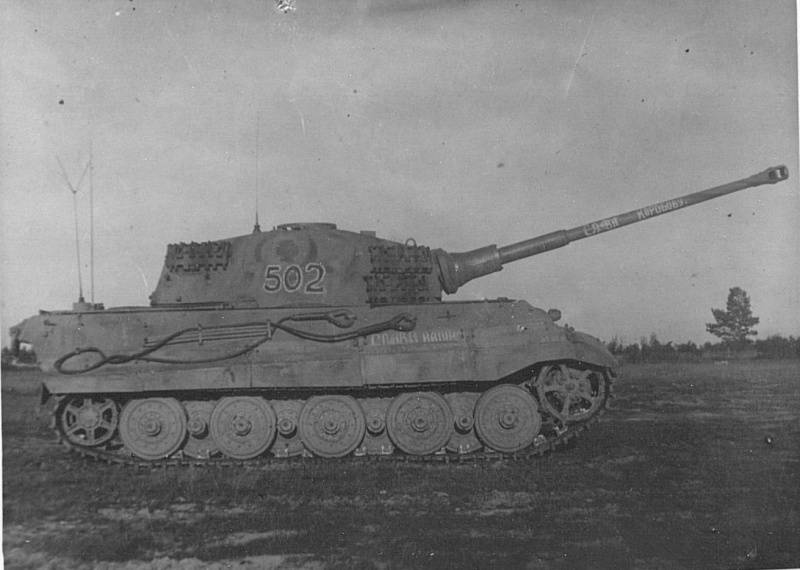
Heavy tank Pz.Kpfw.VI Ausf. B, captured by the Red Army.
It is known that in August-September 1944, during the hostilities in Poland, tankers of the 53rd Guards Tank Brigade of the 6th Guards Tank Corps and the 1st Guards Tank Brigade of the 8th Guards Mechanized Corps captured several serviceable and recoverable tanks. "Tiger II".
A number of sources say that Soviet crews were formed for at least three vehicles.
But no reliable details of the use of these tanks in the Red Army were found.
To be continued ...
- Linnik Sergey
- Use of captured German pistols in the USSR
The use of German captured submachine guns in the USSR
The use of captured German rifles and machine guns in the USSR
The use of captured German machine guns in the USSR
The use of captured German tanks and self-propelled guns in the initial period of the Great Patriotic War
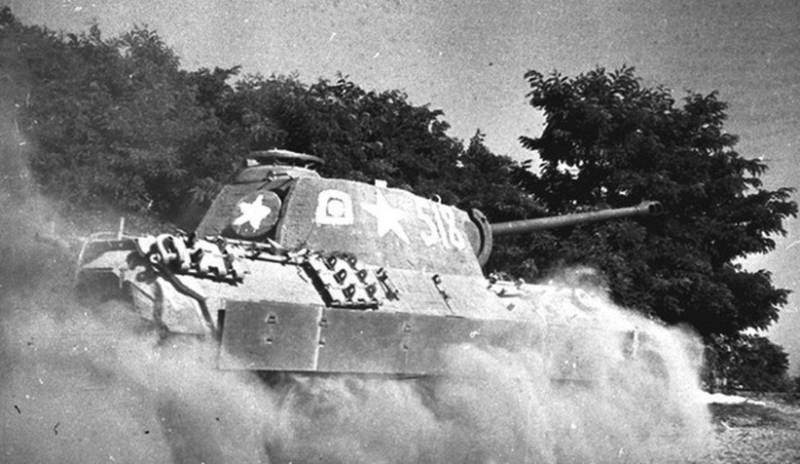
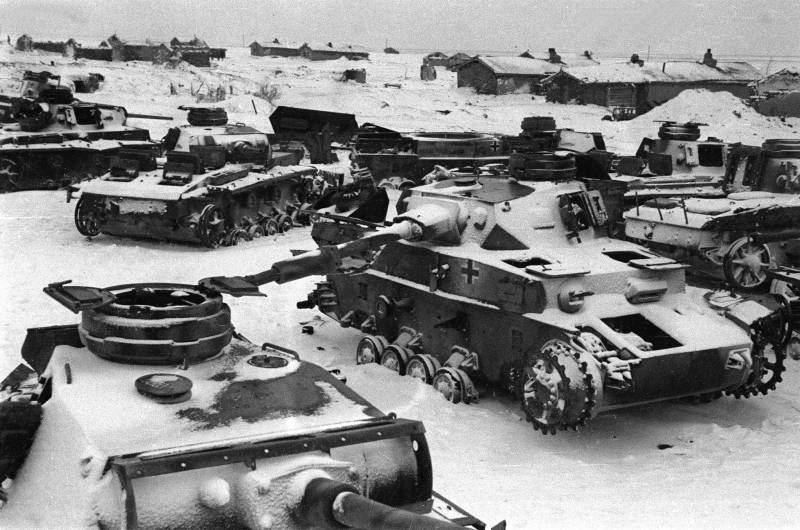
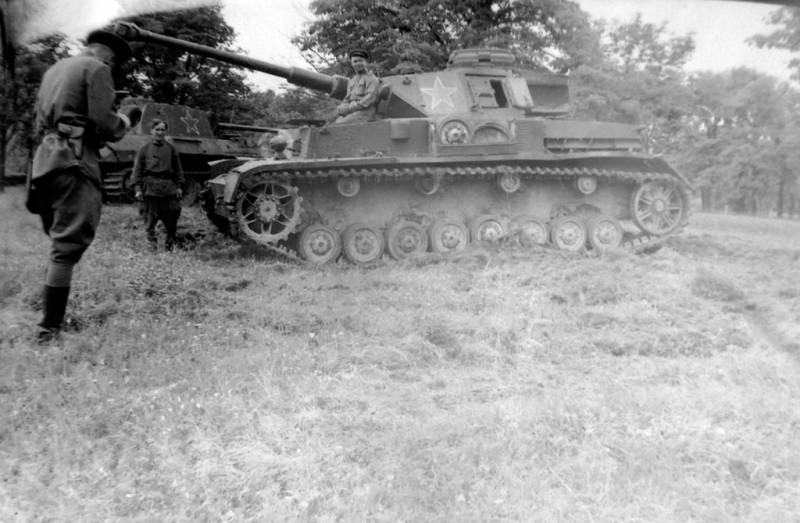
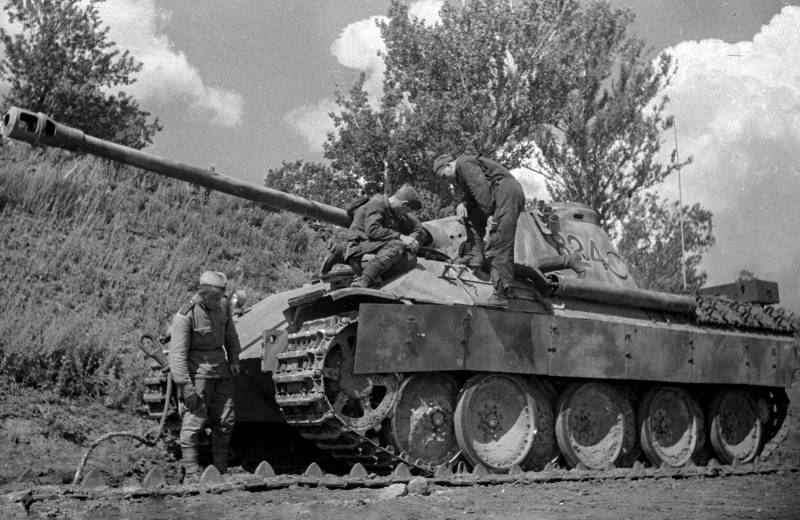
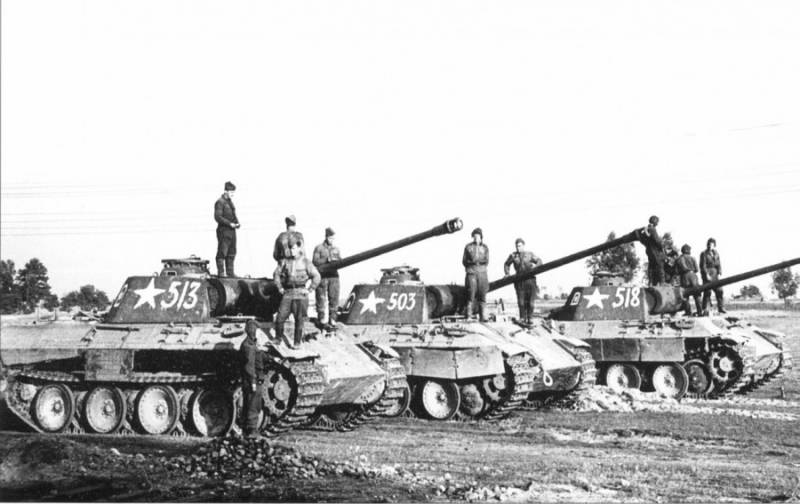
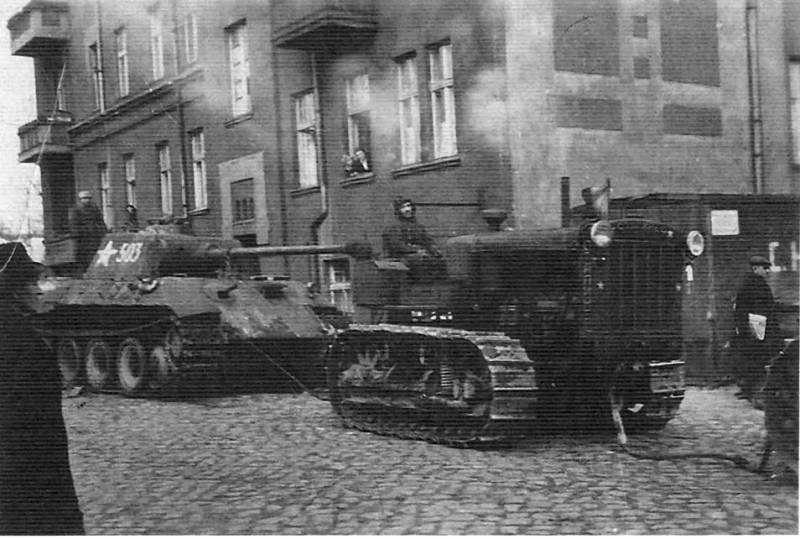
Information